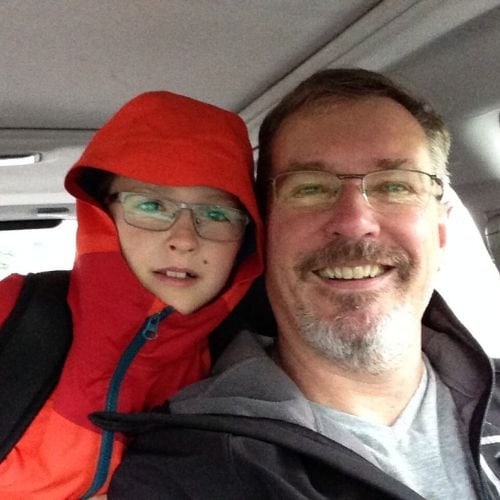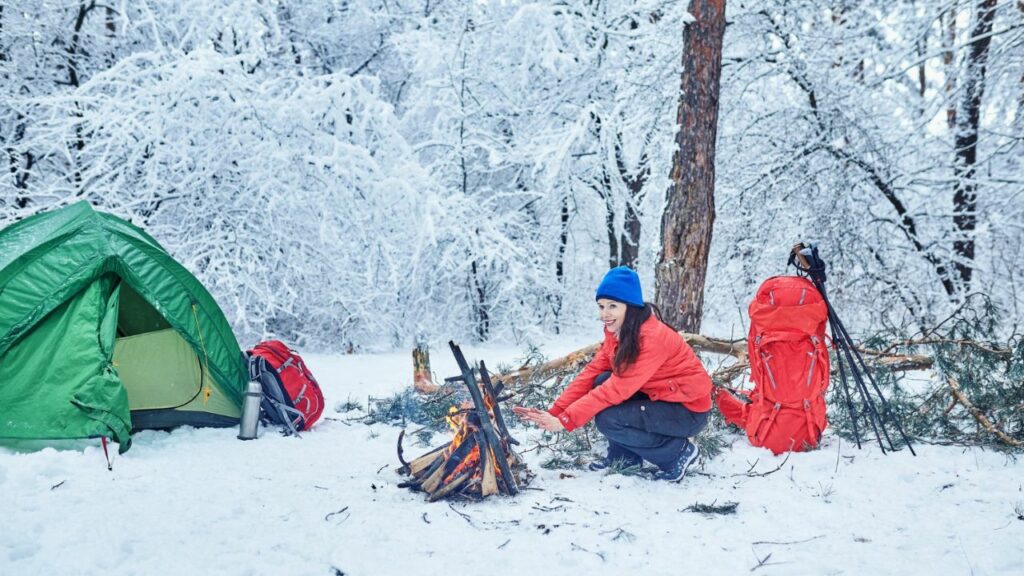We're an affiliate. We hope you love the products we recommend! Just so you know, we may collect a share of sales or other compensation from the links on this page. Thank you if you use our links, we really appreciate it!
Tent camping in 30-degree weather can seem intimidating, but with the right preparation, it’s entirely manageable and even enjoyable.
Embracing the cold offers unique opportunities to experience nature’s quiet beauty and avoid crowded campgrounds.
As the temperature drops, the key to staying comfortable outdoors is layering and proper insulation. Adapting to 30-degree camping conditions starts with choosing the right gear, from sleeping bags and pads to thermal layers and footwear. A well-insulated tent and a rainfly are essential for keeping warm and protected from the elements. Learning to layer effectively is crucial, too, so you stay warm without overheating.
In addition to packing the proper gear, planning activities like hiking and snowshoeing will help you stay warm during the day. Keep in mind that being active while camping in colder weather raises your body temperature, which, in turn, keeps you warm throughout the night. With just a few minor adjustments to your usual camping strategy, you’ll be geared up for a successful 30-degree tent camping adventure.
Selecting the Right Gear

Suitable Tents
When camping in 30-degree weather, it’s essential to choose the right tent. A 4-season tent is highly recommended for cold weather camping, as it can withstand harsh conditions and provide better insulation. Smaller tents are preferable to larger ones, as they can retain heat more effectively.
Sleep Essentials
Your sleep setup is critical in ensuring a comfortable and warm night in cold weather. Start by selecting a sleeping bag rated for at least 30 degrees. A lower temperature rating is better, so you’ll be prepared if temperatures dip further. Adding a sleeping bag liner will provide extra insulation and comfort. Pair your sleeping bag with a high R-value sleeping pad or air mattress to insulate yourself from the cold ground.
Appropriate Clothing
Layering is the key to staying warm during 30-degree camping. Begin with moisture-wicking base layers to keep sweat at bay. Add a mid-layer consisting of insulating materials like fleece or down, and finish with a windproof and waterproof outer layer. Ensure you pack a warm hat, gloves, or mittens, a neck gaiter, and thermal socks to keep extremities warm and protected, even at night.
Essential Equipment
Bring along a reliable camp stove and fuel to heat water and cook hot meals, which is crucial for maintaining energy levels and warmth. Carry a first aid kit to address any potential injuries or medical issues that may arise. Equip yourself with lanterns and headlamps for navigating the campsite in low light. When it’s 30 degrees, you’ll also want a thermos for hot drinks and insulated water bottles to help keep your water supply from freezing.
Decoding the Weather Conditions

Handling 30-degree Weather
When it’s 30 degrees outside, you need to be well-prepared with the right gear to stay safe and comfortable. Here’s what you should consider:
- Hand and feet warmers: These warmers are great for warming up while on a hike or at night in your tent.
- Hot water bottle: An excellent source of warmth while you’re sleeping. Just fill it with water heated over the fire or on the camp stove and stick it down in your sleeping bag.
Dealing with Rain and Snow
Since winter camping can bring rain and snow, it’s crucial to prepare for these weather conditions. Make sure your tent is designed to handle winter weather by checking for the following:
- Four-season tent: Opt for a four-season tent that can withstand snowfall and provide better insulation than a regular three-season tent.
- Waterproof material: Your tent should be made from durable and long-lasting waterproof materials to keep you dry and warm.
- Rainfly: A rainfly is essential for shedding rain and snow while providing extra insulation.
Keep in mind the following tips for a successful cold weather camping experience:
- Set up your camp on higher ground to avoid water accumulation and flooding.
- Clear away snow from your preferred camping spot before pitching your tent.
- Bring additional warmth sources like a portable heater or hot water bottles.
Choosing the Right Campsite

When camping in 30-degree weather, selecting the right campsite is crucial to ensure a comfortable and enjoyable experience. Look for a location that’s sheltered from the wind, as strong winds can significantly lower the temperature and make it feel much colder. Keep an eye out for natural windbreaks such as trees or hills that can provide some protection.
Consider the terrain when choosing a campsite. Aim for a flat spot that slightly slopes to avoid water pooling during rain or snowmelt. Stay away from low-lying areas and valleys where cold air tends to settle, as this can make your campsite considerably colder. Choosing a spot with some sun exposure during the day will help warm your campsite and dry out any damp gear.
Maintaining Body Heat

Proper Dressing
When tent camping in 30-degree weather, it’s crucial to dress appropriately to maintain your body heat. It’s all about layering to trap the warmth and insulate yourself from the cold. Here’s how you can dress strategically:
- Base layer (thermal base layer): Start with a moisture-wicking material like merino wool to keep sweat away from your skin. This layer should be snug but not tight, allowing for some air circulation between the layers.
- Mid layer (insulation layer): Add a layer of insulation with a fleece or down material. This layer can be a little looser than the base layer, trapping air to keep you warm.
- Outer shell layer: For the final layer, wear a waterproof and windproof outer layer to protect against rain, snow, and wind.
Don’t forget about your extremities, as they’re more susceptible to losing heat:
- Head: Wear a beanie or hat to keep your head and ears warm.
- Hands: Opt for mittens or gloves to maintain the heat in your hands.
- Feet: Choose thick, warm socks – preferably wool or merino wool – to provide extra insulation and keep your feet warm and dry.
When you’re inside your tent, you can adjust your layers as needed. Make sure to wear insulating layers and use a quality sleeping pad and sleeping bag to provide additional warmth.
Avoiding Health Hazards

Preventing Hypothermia and Frostbite
When camping in 30-degree weather, it’s crucial to protect yourself from the potential dangers of hypothermia and frostbite. Hypothermia occurs when your body temperature drops significantly below normal, while frostbite is the freezing of your skin and underlying tissues. To prevent these conditions, follow these tips:
- Keep extremities covered: Don a hat, gloves or mittens, and warm socks to protect your head, hands, and feet from the cold.
- Stay dry: Moisture can quickly sap your body heat. Make sure to change out of wet clothing as soon as possible, and avoid sweating by not overdressing or overexerting yourself.
- Eat high-energy foods: Consuming calorie-rich snacks can help keep your body warm and ward off hypothermia.
- Stay active: Keep moving during the day to generate body heat, but remember to rest when needed and avoid overexerting yourself.
Being Wary of Sweat
While it might seem counterintuitive, sweating can be a real concern when camping in colder temperatures. Excess sweat can quickly chill your body when it evaporates, leading to hypothermia. Keep the following tips in mind:
- Avoid overdressing: While it’s important to stay warm, don’t overdress to the point where you’re sweating. Find a balance between warmth and breathability in your clothing.
- Pace yourself: Adjust your physical activities to a comfortable level to avoid sweating. It’s essential to listen to your body and take breaks when needed.
- Choose the right fabrics: Opt for moisture-wicking materials like synthetic or wool blends that will help keep your skin dry by moving sweat away from your body.
- Stay hydrated: Drinking water will help regulate your body temperature and keep your sweat at bay. Try to stick to room temperature or slightly warm drinks to maintain your core temperature.
Preparing for a 30-Degree Weather Camping Trip
Embarking on a camping trip in 30-degree weather requires careful preparation to ensure not only a memorable experience but also a safe one. Here are a final few tips to make sure you plan as well as you can before heading out:
- Research the Location: Before setting off, acquaint yourself with the area where you’ll be camping. Review the local weather forecast and remain alert to any potential shifts in conditions. A good understanding of the terrain will also clue you into the prime spots for setting up camp.
- Plan Ahead: Always inform a trusted individual about your camping whereabouts and the projected duration of your expedition. In the event of unexpected situations, it’s vital for someone to be aware of your general location.
- Packing Checklists: Thoroughly review your gear before departure. Forgetting an essential item is easier than it seems, so draft a detailed checklist. This not only aids in ensuring you’ve packed all necessities but also helps prevent the inclusion of superfluous items.
- Physical Preparation: While 30-degree weather is milder than more extreme cold, it can still be demanding on the body. In the weeks leading up to your trip, consider engaging in light hikes or exercises to bolster your stamina. This regimen will enable you to adjust more seamlessly to the physical exertion of camping in cooler weather.
- Emergency Kit: Assemble a distinct emergency kit stocked with indispensable items like a whistle, flashlight, spare batteries, first-aid essentials, and vital contact information. Such a kit can be invaluable in unforeseen circumstances.
- Stay Flexible: Mother Nature is known for her unpredictability. It’s paramount to be ready to alter your plans or truncate your trip if the weather takes a turn for the worse. Prioritizing your safety is non-negotiable.
Camping in 30-degree weather offers the allure of crisp mornings, frost-kissed landscapes, and the serene ambiance of a chilled environment. But it’s an endeavor that demands some foresight and planning. With the right attitude, equipment, and forethought, your cool-weather camping experience can be safe and enjoyable. So, embrace the journey and the brisk atmosphere.

We’re passionate about getting the most from your car when it comes to going on adventures and road trips. When you take one of these trips you often need more room in your car than you usually would. This is when we come in, to help you find the best roof tent for your car and needs.

